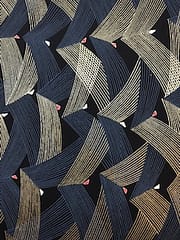Please join the Garden for a traditional demonstration of katazome, a Japanese stencil dyeing technique. This demonstration will take place in the Cathy Rudd Cultural Corner from 1-2pm.
About Katazome

Katazome is a Japanese stencil dyeing technique. It is a paste-resist process used to dye cloth and paper. This dyeing technique utilizes natural materials – paper, rice paste and soymilk. Katazome means ‘repeat dying”, referring to the use of a stencil to create a repetitive pattern. Traditional Katazome designs feature natural motifs, such as flowers and birds.
The first part of the process is to create a stencil which is made with hand-made mulberry paper, called shibugami, the process to make shibugami is to soak the paper in persimmon tannin which makes it waterproof. Rice paste is used as the resist and is applied through the stencil onto the fabric or paper. Once the rice paste cures, the fabric is submerged in a dye bath. After the depth of color is achieved, the fabric is dried and then the paste is rinsed off. Katazome is often referred to as an early version of screen-printing.